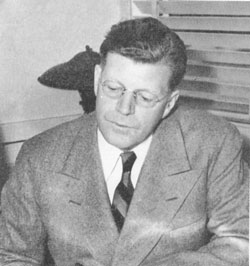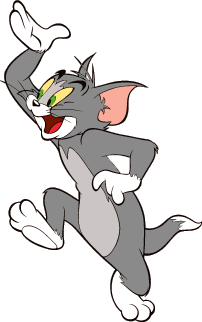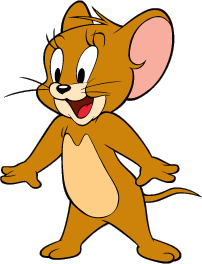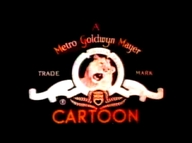
Charles Martin Jones was an American animator, painter, voice actor and filmmaker, best known for his work with Warner Bros. Cartoons on the Looney Tunes and Merrie Melodies series of shorts. He wrote, produced, and/or directed many classic animated cartoon shorts starring Bugs Bunny, Daffy Duck, Wile E. Coyote and the Road Runner, Pepé Le Pew, Marvin the Martian, and Porky Pig, among others.

Frederick Clinton Quimby was an American animation producer and journalist best known for producing the Tom and Jerry cartoon series, for which he won seven Academy Awards for Best Animated Short Films. He was the film sales executive in charge of the Metro-Goldwyn-Mayer cartoon studio, which included Tex Avery, Droopy, Butch Dog, Barney Bear, Michael Lah and multiple one-shot cartoons, as well as William Hanna and Joseph Barbera, the creators of Tom and Jerry.

Thomas Jasper "Tom" Cat Sr. is a fictional character and one of the two titular main protagonists in Metro-Goldwyn-Mayer's series of Tom and Jerry theatrical animated short films. Created by William Hanna and Joseph Barbera, he is a grey and white anthropomorphic domestic short haired tuxedo British cat who first appeared in the 1940 MGM animated short Puss Gets the Boot. The cat was known as "Jasper" during his debut in the short; however, beginning with his next appearance in The Midnight Snack he was known as "Tom" or "Thomas".
DePatie–Freleng Enterprises was an American animation studio founded by former Warner Bros. Cartoons employees in May 1963, before dissolving in 1981. Based in Burbank, California, DFE produced animation for film and television.
Maurice James Noble was an American animation production designer, background artist and layout designer whose contributions to the industry spanned more than 60 years. He was a long-time associate and right-hand man of animation director Chuck Jones, especially at Warner Bros. in the 1950s. His work contributed to such cartoon classics as Duck Dodgers in the 24½th Century, What's Opera, Doc? and the Road Runner series.

Gerald Jinx "Jerry" Mouse is a fictional character and one of the two titular characters in Metro-Goldwyn-Mayer's series of Tom and Jerry theatrical animated short films and other animated media, usually acting as the protagonist opposite his rival Tom Cat. Created by William Hanna and Joseph Barbera, Jerry is an anthropomorphic brown house mouse, who first appeared as a mouse named Jinx in the 1940 MGM animated short Puss Gets the Boot. Hanna gave the mouse's original name as "Jinx", while Barbera claimed the mouse went unnamed in his first appearance.
Tom and Jerry is an American animated media franchise and series of comedy short films created in 1940 by William Hanna and Joseph Barbera. Best known for its 161 theatrical short films by Metro-Goldwyn-Mayer, the series centers on the rivalry between the titular characters of a cat named Tom and a mouse named Jerry. Many shorts also feature several recurring characters.
Thomas Archer Ray was an American animator.
Philip Roman is an American animator and the director of the Peanuts and Garfield animated specials. He is the founder of the animation studios Film Roman and Phil Roman Entertainment.

David Hudson DePatie was an American film and television producer who was the last and longest lived executive in charge of the original Warner Bros. Cartoons studio. He also formed DePatie–Freleng Enterprises, with Friz Freleng, Hanna-Barbera Productions and was an executive producer at Marvel Productions.
This is a complete list of the 166 shorts in the Tom and Jerry series produced and released between 1940 and 2021. Of these, 162 are theatrical shorts, one is a made-for-TV short, one is a two-minute sketch shown as part of a telethon, and two are special shorts released on HBO Max.

The Phantom Tollbooth is a 1970 American live-action/animated fantasy film based on Norton Juster's 1961 children's book of the same name. Produced by Chuck Jones at MGM Animation/Visual Arts, the film stars Butch Patrick as Milo, alongside the voice talents of Mel Blanc, Daws Butler, Candy Candido, Hans Conried, June Foray, Patti Gilbert, Shepard Menken, Cliff Norton, Larry Thor, and Les Tremayne. Jones also co-directed the film with Abe Levitow, while Dave Monahan directed the live-action segments. Completed in 1968, the film was held up from release by MGM until late 1970 due to internal studio problems. The animation studio closed soon after the film's release, with MGM leaving the animation business until 1993 with the startup of their new Metro-Goldwyn-Mayer Animation studio.

How the Grinch Stole Christmas! is a 1966 American animated television special, directed and co-produced by Chuck Jones. It is based on the 1957 children's book of the same name by Dr. Seuss, and tells the story of the Grinch, who tries to ruin Christmas for the townsfolk of Whoville below his mountain hideaway.
Don Towsley was an animator working at Walt Disney Animation Studios, and later at MGM and Filmation.

The Metro-Goldwyn-Mayer cartoon studio was an American animation studio operated by Metro-Goldwyn-Mayer (MGM) during the Golden Age of American animation. Active from 1937 until 1957, the studio was responsible for producing animated shorts to accompany MGM feature films in Loew's Theaters, which included popular cartoon characters Tom, Jerry, Droopy, Butch, Spike, Tyke, and Barney Bear.
Irven LeRoy Spence was an American animator. He is best known for his work on MGM's Tom and Jerry animated shorts. Spence has been credited variously as Irven Spence, Irvin Spence, and Irv Spence.
Tom and Jerry Golden Collection was a scrapped series of two-disc DVD and Blu-ray sets produced by Warner Home Video that was expected to collect all 161 theatrical Tom and Jerry cartoon shorts released by Metro-Goldwyn-Mayer from the 1940s through the 1960s. Only the first of the three planned volumes was released, on October 25, 2011. It features 37 shorts, roughly one-third of the 113 Tom and Jerry shorts that had been included in the Tom and Jerry Spotlight Collection, a previous DVD series that focused on the shorts directed by William Hanna and Joseph Barbera from 1940 to 1958.
Lloyd Lincoln Vaughan I was an American animator known for his work at Warner Bros. Cartoons under the supervision of Chuck Jones. Starting in 1936 as an inbetweener, and he only got paid $6.00 a week, he became an animator in 1944 or '45 under Jones, and animated for him until the studio's brief closure in 1953. His most iconic work is the flower scene in Duck Amuck. In 1966, he reunited with Jones at MGM Animation/Visual Arts until 1970, and would continue to animate until his death.

The Bear That Wasn't is a 1967 American animated short film directed by Chuck Jones and based on the children's book The Bear That Wasn't by Frank Tashlin. It is the final cartoon produced and released by Metro-Goldwyn-Mayer via its MGM Animation/Visual Arts division.









